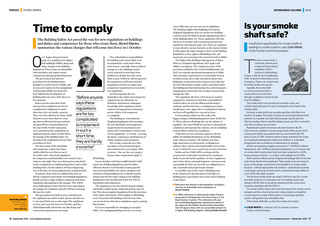




VOICES | HYWEL DAVIES Time to comply The Building Safety Act paved the way for new regulations on buildings and duties and competence for those who create them. Hywel Davies summarises the various changes that will come into force on 1 October O n 17 August, the government made new regulations for HigherRisk Buildings (HRBs), along with major changes to the Building Regulations. These create new dutyholder roles and duties, and require certain competences and appropriate behaviours. The government also laid new procedures for the Building Safety Regulator to control work on HRBs, and set out a new regime for the management of all occupied HRBs. For those who have followed the development of building safety law since 2018, there are few surprises. Before anyone raises their hand and says these regulations are far too complicated to implement in such a short time, they are hardly a surprise. They were first called for by Dame Judith Hackitts review more than five years ago, then confirmed when government accepted all her recommendations at the end of 2018. Further indications were contained in the consultation on implementing the report in 2019, before the passage of the Building Safety Act introduced the enabling powers for these procedures in 2022. The finer points of the dutyholder and competence regime that Dame Judith called for were first set out in November 2021, when draft regulations for competence and dutyholders were issued to give industry early sight. They were discussed in some detail in the consultations on implementing Parts 3 and 4 of the Building Safety Act last summer. All that is happening now is that they are being implemented, as long foretold. In practice, those who are confident that they are already competent and comply with Building Regulations should not have a major problem complying with these regulations and adapting to the changes. They will be most challenging for those who have been operating at the margins of compliance and who will have to change the way they work. The government has held its nerve and delivered the regulations as it said it would. Anyone who bet on a U-turn may find it was a costly wager. The regulations are here and come into force on 1 October, and they will fundamentally reform the way that design and construction appointments are made. Before anyone says these regulations are far too complicated to implement in such a short time, they are hardly a surprise DR HYWEL DAVIES HonFCIBSE is chief technical officer at CIBSE www.cibse.org 16 September 2023 www.cibsejournal.com They will rebalance responsibilities for building work and are likely to be accompanied by much more robust enforcement, especially where problems emerge on a site. Building Control can be expected to work back from problems to identify how they arose. That, in turn, is likely to call into question the competence of all concerned and compliance with the new duties and competence requirements set out in the new regulations. Not knowing what the new dutyholder roles, duties and competency requirements are will almost, by definition, demonstrate inadequate knowledge of the regulations and be evidence of inappropriate behaviours, and so a failure to be competent or compliant. The Building etc. (Amendment) (England) Regulations 2023 introduce the new dutyholder and competence requirements for practitioners and clients. Part 2A introduces a whole series of new regulations 17 in total covering the duties, competence and behaviour of clients, designers and contractors. Part 2A also creates the new roles and duties of the principal designer and contractor for every project. That is correct they are for every project, because these requirements apply to all buildings. Anyone familiar with Dame Judith Hackitts 2018 report into Building Regulations and Fire Safety will know that she recommended creating specific roles and responsibilities for clients, designers and contractors doing building work. It should surprise nobody that the first major change to the Building Regulations is the introduction of the new Part on dutyholders and competence. The regulations revise the rules for deposit of plans and further embed energy-related procedures into UK law. They also strengthen Regulation 38 on the provision of fire safety information, which applies to all building work. If you deal with Building Control in any form, you need to know what these regulations require, starting this October. If you are responsible for managing an occupied HRB, or for managing building work in, or to create,